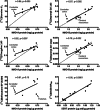Distribution of monoamine oxidase proteins in human brain: implications for brain imaging studies
- PMID: 23403377
- PMCID: PMC3677103
- DOI: 10.1038/jcbfm.2013.19
Distribution of monoamine oxidase proteins in human brain: implications for brain imaging studies
Abstract
Positron emission tomography (PET) imaging of monoamine oxidases (MAO-A: [(11)C]harmine, [(11)C]clorgyline, and [(11)C]befloxatone; MAO-B: [(11)C]deprenyl-D2) has been actively pursued given clinical importance of MAOs in human neuropsychiatric disorders. However, it is unknown how well PET outcome measures for the different radiotracers are quantitatively related to actual MAO protein levels. We measured regional distribution (n=38) and developmental/aging changes (21 hours to 99 years) of both MAOs by quantitative immunoblotting in autopsied normal human brain. MAO-A was more abundant than MAO-B in infants, which was reversed as MAO-B levels increased faster before 1 year and, unlike MAO-A, kept increasing steadily to senescence. In adults, regional protein levels of both MAOs were positively and proportionally correlated with literature postmortem data of MAO activities and binding densities. With the exception of [(11)C]befloxatone (binding potential (BP), r=0.61, P=0.15), correlations between regional PET outcome measures of binding in the literature and MAO protein levels were good (P<0.01) for [(11)C]harmine (distribution volume, r=0.86), [(11)C]clorgyline (λk3, r=0.82), and [(11)C]deprenyl-D2 (λk3 or modified Patlak slope, r=0.78 to 0.87), supporting validity of the latter imaging measures. However, compared with in vitro data, the latter PET measures underestimated regional contrast by ∼2-fold. Further studies are needed to address cause of the in vivo vs. in vitro nonproportionality.
Figures






Comment in
-
[11C]befloxatone distribution is well correlated to monoamine oxidase A protein levels in the human brain.J Cereb Blood Flow Metab. 2014 Dec;34(12):1951-2. doi: 10.1038/jcbfm.2014.157. Epub 2014 Sep 17. J Cereb Blood Flow Metab. 2014. PMID: 25227605 Free PMC article.
Similar articles
-
Positron emission tomography quantification of [11C]-harmine binding to monoamine oxidase-A in the human brain.J Cereb Blood Flow Metab. 2006 Mar;26(3):330-44. doi: 10.1038/sj.jcbfm.9600197. J Cereb Blood Flow Metab. 2006. PMID: 16079787
-
The pro-psychotic metabotropic glutamate receptor compounds fenobam and AZD9272 share binding sites with monoamine oxidase-B inhibitors in humans.Neuropharmacology. 2020 Jan 1;162:107809. doi: 10.1016/j.neuropharm.2019.107809. Epub 2019 Oct 4. Neuropharmacology. 2020. PMID: 31589885
-
Elevated monoamine oxidase a levels in the brain: an explanation for the monoamine imbalance of major depression.Arch Gen Psychiatry. 2006 Nov;63(11):1209-16. doi: 10.1001/archpsyc.63.11.1209. Arch Gen Psychiatry. 2006. PMID: 17088501
-
Classics in Neuroimaging: Development of PET Tracers for Imaging Monoamine Oxidases.ACS Chem Neurosci. 2019 Apr 17;10(4):1867-1871. doi: 10.1021/acschemneuro.9b00081. Epub 2019 Feb 21. ACS Chem Neurosci. 2019. PMID: 30789704 Free PMC article. Review.
-
Translational neuroimaging: positron emission tomography studies of monoamine oxidase.Mol Imaging Biol. 2005 Nov-Dec;7(6):377-87. doi: 10.1007/s11307-005-0016-1. Mol Imaging Biol. 2005. PMID: 16265597 Review.
Cited by
-
Development and Clinical Application of Positron Emission Tomography Imaging Agents for Monoamine Oxidase B.Front Neurosci. 2022 Feb 25;15:773404. doi: 10.3389/fnins.2021.773404. eCollection 2021. Front Neurosci. 2022. PMID: 35280341 Free PMC article. Review.
-
Monoamine oxidase A: An emerging therapeutic target in prostate cancer.Front Oncol. 2023 Feb 13;13:1137050. doi: 10.3389/fonc.2023.1137050. eCollection 2023. Front Oncol. 2023. PMID: 36860320 Free PMC article. Review.
-
Monoamine Oxidase B Total Distribution Volume in the Prefrontal Cortex of Major Depressive Disorder: An [11C]SL25.1188 Positron Emission Tomography Study.JAMA Psychiatry. 2019 Jun 1;76(6):634-641. doi: 10.1001/jamapsychiatry.2019.0044. JAMA Psychiatry. 2019. PMID: 30840042 Free PMC article.
-
Putative presynaptic dopamine dysregulation in schizophrenia is supported by molecular evidence from post-mortem human midbrain.Transl Psychiatry. 2017 Jan 17;7(1):e1003. doi: 10.1038/tp.2016.257. Transl Psychiatry. 2017. PMID: 28094812 Free PMC article.
-
Greater monoamine oxidase a binding in perimenopausal age as measured with carbon 11-labeled harmine positron emission tomography.JAMA Psychiatry. 2014 Aug;71(8):873-9. doi: 10.1001/jamapsychiatry.2014.250. JAMA Psychiatry. 2014. PMID: 24898155 Free PMC article.
References
-
- Ginovart N, Meyer JH, Boovariwala A, Hussey D, Rabiner EA, Houle S, et al. Positron emission tomography quantification of [11C]-harmine binding to monoamine oxidase-A in the human brain. J Cereb Blood Flow Metab. 2006;26:330–344. - PubMed
-
- Meyer JH, Ginovart N, Boovariwala A, Sagrati S, Hussey D, Garcia A, et al. Elevated monoamine oxidase a levels in the brain: an explanation for the monoamine imbalance of major depression. Arch Gen Psychiatry. 2006;63:1209–1216. - PubMed
-
- Meyer JH, Wilson AA, Sagrati S, Miler L, Rusjan P, Bloomfield PM, et al. Brain monoamine oxidase A binding in major depressive disorder: relationship to selective serotonin reuptake inhibitor treatment, recovery, and recurrence. Arch Gen Psychiatry. 2009;66:1304–1312. - PubMed
Publication types
MeSH terms
Substances
Grants and funding
LinkOut - more resources
Full Text Sources
Other Literature Sources

